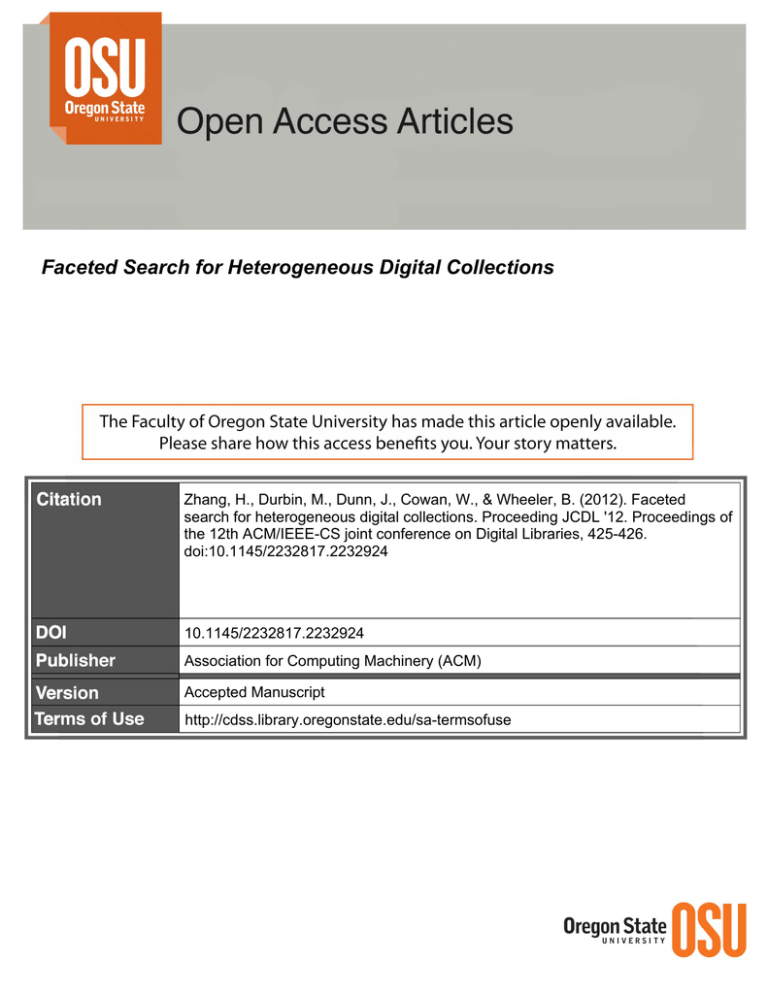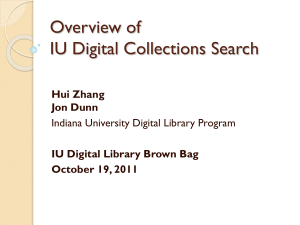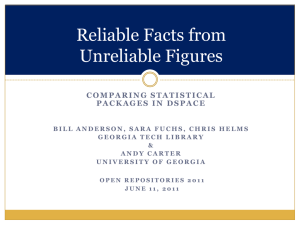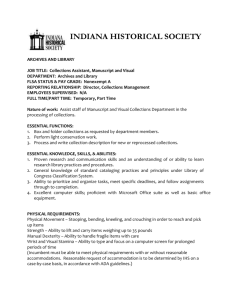Faceted Search for Heterogeneous Digital Collections
advertisement

Faceted Search for Heterogeneous Digital Collections
Zhang, H., Durbin, M., Dunn, J., Cowan, W., & Wheeler, B. (2012). Faceted
search for heterogeneous digital collections. Proceeding JCDL '12. Proceedings of
the 12th ACM/IEEE-CS joint conference on Digital Libraries, 425-426.
doi:10.1145/2232817.2232924
10.1145/2232817.2232924
Association for Computing Machinery (ACM)
Accepted Manuscript
http://cdss.library.oregonstate.edu/sa-termsofuse
Faceted Search for Heterogeneous Digital Collections
Hui Zhang
Digital Library Program
Jon Dunn, Will Cowan
Indiana University
Bloomington, Indiana USA
Digital Library Program
Indiana University
Bloomington, Indiana USA
hz3@indiana.edu
{jwd, wgcowan}@indiana.edu
ABSTRACT
The idea of faceted search has received growing attentions in the
digital library field for its potential of improving user satisfaction
by combing the query and browse strategies interactively.
Furthermore, with the trend of using digital repositories as the
central infrastructure for curation and preservation, there is a
demand for a single search interface providing public access to all
the diversified content stored in the repositories. In this demo, we
present Digital Collections Search, a system that is designed to
assist users who are unfamiliar with the subject of their
information needs locating relevant items as well exploring
related but unknown collections in the repository.
Categories and Subject Descriptors
H.3.7 [Information Search and Retrieval]: Digital Libraries
General Terms
Management, Design, Human Factors.
Keywords
Faceted search, discovery interface, fedora common, solr,
blacklight, disseminator.
1.
INTRODUCTION
A common challenge to discovery interface design is that the
average users of digital library systems cannot specify their
information needs appropriately due to the lack of knowledge on
the subject. The problem is only intensified when libraries keep
adding digitized contents of various types and from different
domains into their repositories. For instance, the repository
maintained by Indiana University’s Digital Library Program
(DLP) holds more than 100 collections with a variety of content
types such as images, manuscripts, and sheet music. Although
some of the collections have their own public websites, it is
impractical to exploit this rich resource without a unified
discovery interface because otherwise a potential user will have to
search his topics on every single collection individually.
Mike Durbin, Brian Wheeler
Digital Library Program
Indiana University
Bloomington, Indiana USA
{midurbin,
bdwheeler}@indiana.edu
Although a faceted search interface to a union catalog is not a new
idea, for instance the North Carolina State University Library’s
OPAC (Online Public Access Catalog), the DCS system is
innovative in its supporting of contents generated from different
metadata standards (e.g., EAD and MODS) and complicated
workflows (e.g., flexible collection branding) by: creating an
index framework serving as the middleware to synchronize the
repository and discovery interface, developing Fedora services to
“normalize” the digitized items and provide standardized output
through web service.
2. SYSTEM OVERVIEW
2.1 Architecture
The general procedure of creating Solr index for the collections in
Fedora will be briefly described in this section. Figure 1 illustrates
the system architecture, which includes three layers: the back-end
layer of Fedora repository, the middle layer of index framework,
and the front-end layer of faceted discovery interface. The
repository layer is responsible for providing MODS record for
each digitized item, using a locally developed Fedora
disseminator called getMODS, as input for the index layer. The
middle layer of index service, called Fedora-index-service
framework [1], is in charge of creating the Solr and Lucene
indices for the MODS records. The framework is implemented as
a RESTful web service application written specially to generate
index for digitized items with complex structures (e.g., journals
and books) while in sync with the Fedora repository. However,
this framework does not support searching and browsing the index,
therefore a discovery interface is developed in separate to allow
public access to the indexed contents. The next two sections will
discuss in details on how the Solr index is created and the design
of the discovery interface.
In this paper, we demonstrate Digital Collections Search (DCS), a
system developed by DLP that supports exploratory search across
collections preserved in its Fedora Commons repository.
Permission to make digital or hard copies of all or part of this work for
personal or classroom use is granted without fee provided that copies are
not made or distributed for profit or commercial advantage and that
copies bear this notice and the full citation on the first page. To copy
otherwise, or republish, to post on servers or to redistribute to lists,
requires prior specific permission and/or a fee.
JCDL’12, June 10–14, 2012, Washington, DC, USA.
Copyright 2012 ACM 978-1-4503-1154-0/12/06...$10.00.
Figure 1: System Architecture
2.2
Building the Solr Index
Solr, an open source index server, is chosen as the framework for
building the index because of its robustness and support for
faceted search. Items in Fedora that will be included in the Solr
index must associate themselves with the getMODS disseminator
so the indexing routine only needs to handle one format no matter
what metadata standards were used during the cataloging process.
The generated MODS records will then be converted into a XMLstyle format that is native to Solr and indexed. All the input and
output files for indexing are delivered as streams of raw bytes to
save processing time and storage space.
their values are stored in Fedora and exposed using disseminator.
After all, seven index fields are chosen as facets, where three of
them, namely Format, Collection, and Source, are extracted from
Fedora and passed directly to the indexer. In contrast, the other
four facets are translated from the corresponding MODS fields
based on the following mapping patterns:
Quality control and live update are two major challenges of
incorporating the Solr index service with DLP's production
system. Quality control, the procedure of keeping the indexed
content correct and up-to-date, is involved across the whole
workflow of indexing. For instance, an item may have to be
removed from the index because it is unrelated with the collection.
Therefore, the index service must implement routines to restrict
problematic item from public access. Several measures are added
to ensure this goal: a new field called recordStatus is created in
MODS to register whether the item has completed the cataloging
process; a Fedora service is created to confirm whether an item is
eligible for public view; and the indexing program will check
certain MODS fields to make sure they meet the expected pattern.
Live update is a customer raised feature that argues a digitized
item should become available for the public view as soon as it has
been cataloged. It requires that the Solr indexing speed must
match the Fedora ingestion speed; it also demands a
communication mechanism in between so that Fedora is able to
notify the index service once an update to the repository is made.
Through experiments, it is clear that the indexing process is
slowed down mostly because of the Solr commit operation, and
the solution is to specify the maxTime property of Solr's
autoCommit configuration to the value (30000 ms) that will
trigger the commit operation only when there were documents
updated in the last five minutes. This change in Solr configuration
is important to keep the repository and the index in
synchronization especially during massive Fedora ingestion when
thousands of digitized items are imported into the repository in
batch mode.
The communication mechanism between Fedora and Solr indexer
is built with the Java Message Service (JMS), where the Fedora
server is specified as publisher and the index service is setup as
the listener. Fedora will broadcast notice when an item is added or
updated, and the indexing routine subscribed to the messages will
in response start the process of (re) indexing that item.
2.3
The Discovery Interface
The discovery interface at the front-end is designed with the goal
of assisting non-expert users in locating relevant items without the
knowledge of the subject. Blacklight, an open source online
public access catalog project, is chosen as the platform to develop
the search interface because it is developed primarily for library
usage and supports search with Solr index out-of-box.
Identifying the facet fields is a vital task for discovery interface
design. All the facets used in DCS are data driven, which means
Topic facet: mods:subject|mods:topic
Creator facet: mods:namepart
Genre facet: mods:genre
Year facet: mods:originalInfo[@keyDate and @w3cdtf]
Figure 2. Snapshot of IU Digital Collections Search
A snapshot of the faceted search interface is depicted in Figure 2.
In this example, it provides results to a keyword search of war of
1812, where the user can choose either narrowing down his
request or exploring new items by picking the appropriate facets
(e.g., picking a topic facet to specify requirement or a different
collection to explore the repository) shown in the left pane.
Selecting a different facet will initiate a new Solr search and the
results will be rendered in the primary window on the right, and a
click on the item title or its thumbnail will redirect the user to a
webpage that will show the item in its full details.
3.
FUTURE PLAN
DCS is still at Beta stage; we are adding new collections and
collecting user feedbacks at this time. There is a plan for
improvement and new features on top of the list are: supporting
full-text search, recognizing and indexing new Fedora collections
automatically. We also want to explore the possibility of
integrating DCS with traditional library catalog and using it for
video search.
4.
REFERENCES
[1] Durbin, M. and Dunn, J. (2008) Accommodating Diverse
Search Requirements over a Fedora Repository. In: Third
international Conference on Open Repositories 2008. 1-4
April 2008, Southampton, United Kingdom.





